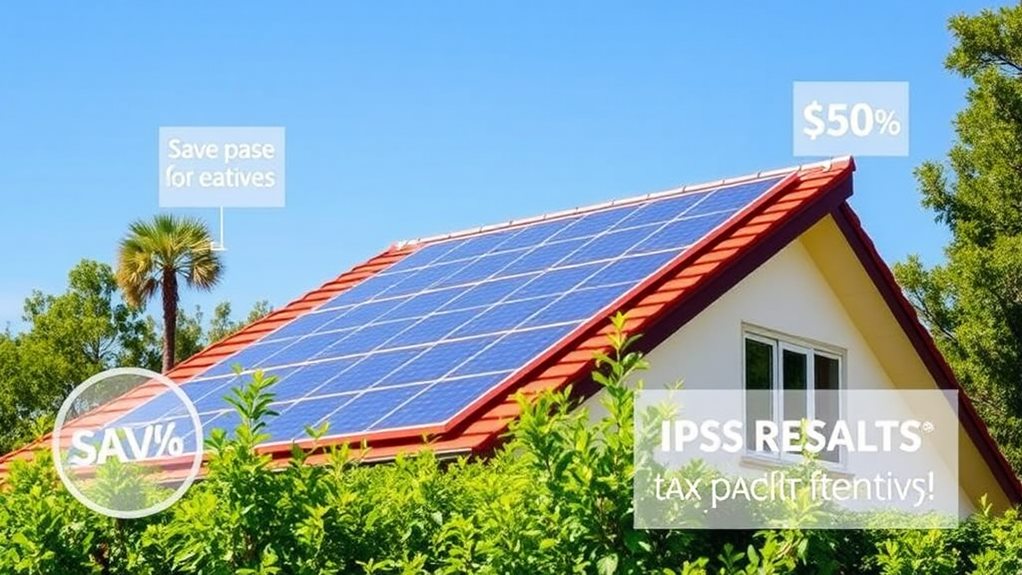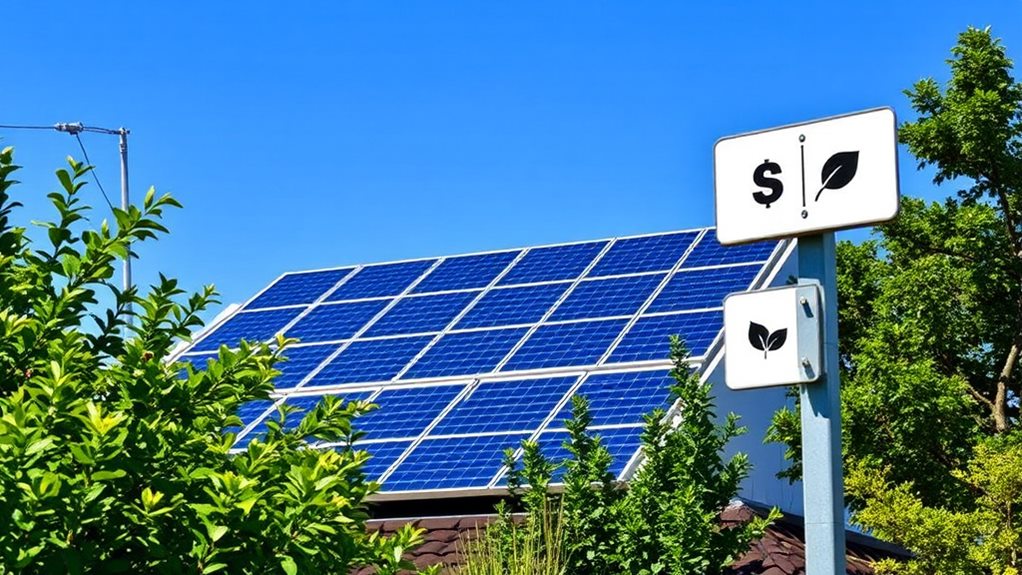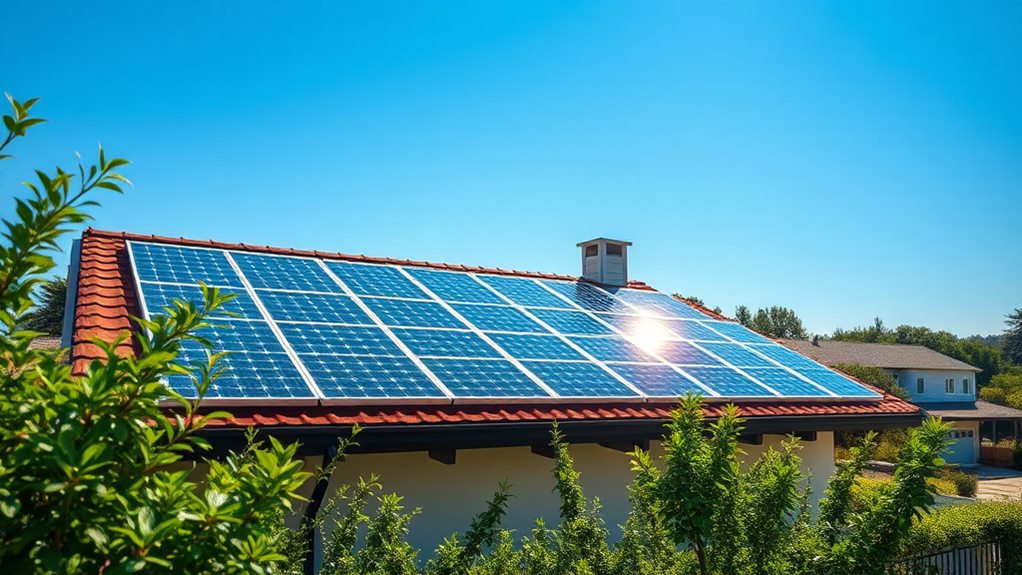To maximize your state's solar installation incentives, start by understanding the federal Investment Tax Credit (ITC), which offers a 30% deduction on installation costs that decreases over time. Research local utility rebates, like those from Austin Energy or Denton Municipal Electric, which can considerably lower your upfront expenses. Additionally, explore property tax exemptions available in certain states, preventing tax increases due to solar investments. Utilize buyback programs to earn credits for excess energy produced. By strategically leveraging these incentives, you can enhance your financial benefits from solar energy installations and understand how to optimize your investment further.
Understanding Solar Incentives

Understanding solar incentives can be a game-changer for your energy costs. By leveraging various incentives, you can considerably reduce the upfront expenses associated with solar panel installations. One of the most impactful options is the federal Investment Tax Credit (ITC), which currently provides a 30% tax deduction on installation costs. However, this rate will decrease to 22% in 2024, so taking action soon is crucial.
Additionally, many homeowners find that the potential to eliminate utility bills entirely with solar investment makes these incentives even more appealing long-term savings from solar energy.
In Texas, solar incentives are particularly advantageous. Many utility companies offer rebate programs that vary based on system size; for instance, American Electric Power may provide up to $3,000 for larger installations.
Additionally, Texas homeowners enjoy a property tax exemption, ensuring that the increased property value from solar installations doesn't lead to higher taxes, further enhancing your energy savings.
It's essential to research local incentives as they can differ considerably across municipalities. By understanding these solar incentives, you can maximize your financial benefits and make the most of your investment in renewable energy.
Take the time to explore all available opportunities and position yourself for substantial savings on your energy bills.
Tax Credits and Rebates Overview
When it comes to maximizing your solar investment, tax credits and rebates play a pivotal role in reducing overall installation costs. In Texas, you can benefit from the federal Investment Tax Credit (ITC), which allows homeowners to claim 30% of installation costs as a solar tax credit. This percentage decreases to 26% in 2034 and 22% in 2035, so acting sooner can yield considerable savings.
Additionally, various solar energy incentives are available that further enhance your financial return. For instance, a $24,000 solar system would effectively cost you around $16,800 after applying the tax credit.
Additionally, Texas provides an exemption for solar installations from property taxes, enabling you to increase your home's value without the burden of additional taxes. Local utilities also offer various rebate programs; for example, American Electric Power can give you up to $3,000 for larger systems, while Austin Energy provides $2,500 for qualifying installations.
Although Texas lacks a statewide net metering program, many local utilities will compensate you for any excess solar energy generated, enhancing your financial benefits. Together, these incentives can considerably boost your energy efficiency investment and make solar energy a more attractive option for your home.
Local Programs and Offers

In Texas, local programs and offers can greatly enhance your solar installation experience and financial savings. Many Texas utility companies, like Austin Energy and Denton Municipal Electric, provide significant solar panel rebates to encourage residents to adopt solar technology. For instance, Austin Energy offers rebates up to $2,500 for qualifying installations, while Denton Municipal Electric can fund up to $30,000 or 50% of installation costs for eligible projects.
Additionally, these incentives can lead to significant savings on installation costs, as noted in the financial incentives available for solar energy.
Moreover, the SMART Source Program from American Electric Power grants rebates based on system size, allowing for a maximum rebate of $3,000 for installations exceeding 7.5 kW. Local programs, such as SMTX Utilities and Sunset Valley, further tailor incentives to promote solar energy utilization within their communities.
Furthermore, solar buyback programs, including Austin Energy's Value of Solar rate at 9.91 cents per kWh, compensate you for surplus solar energy generated by your system. These programs can provide financial returns on your energy production, making the shift to solar even more appealing.
Utility-Specific Incentives
When you're considering solar installation, it's essential to explore utility-specific incentives that can greatly boost your savings.
Many utility companies offer buyback programs, compensating you for the excess energy your system generates, while local rebates can further offset installation costs.
Additionally, researching finding affordable solar installers can help you secure competitive pricing.
Understanding these options will help you maximize your investment and enjoy the benefits of solar energy.
Utility Buyback Programs
Utility buyback programs offer a fantastic opportunity for homeowners in Texas to earn money from their solar energy systems.
These programs allow you to receive compensation for excess solar energy generated, which can greatly enhance your financial returns. For instance, Austin Energy provides a Value of Solar rate at 9.91 cents per kWh for residential systems under 1MW, directly rewarding you for your solar production.
CPS Energy, on the other hand, reimburses customers for surplus energy at avoided cost rates that may vary based on market conditions.
Additionally, other utilities like Brenham and Brownsville PUB have their own reimbursement mechanisms, with rates that could differ from the statewide average.
Local Rebate Opportunities
Homeowners looking to maximize their solar investment can take advantage of local rebate opportunities offered by various utilities across Texas. These utility-specific programs can greatly reduce your installation costs and enhance your financial returns.
For instance, American Electric Power provides a solar panel rebate of up to $3,000 for systems exceeding 7.5 kW. Meanwhile, Austin Energy offers a $2,500 rebate for qualifying solar installations, but you'll need to complete a solar education course first.
Denton Municipal Electric stands out with its generous rebates, covering up to $30,000 or 50% of the installation costs for solar panels. Additionally, both SMTX Utilities and Sunset Valley have their own unique programs, promoting solar energy adoption through varying compensation structures.
Don't overlook the reimbursement for surplus energy offered by CPS Energy, which can further enhance your financial returns at avoided cost rates.
Financial Benefits of Solar

When you invest in solar energy, you're not just going green; you're also revealing significant financial benefits.
With the federal solar tax credit allowing you to deduct 30% of your installation costs, combined with local utility rebates, your initial expenses can dramatically decrease.
Over time, the long-term savings on your electricity bills can add up to substantial amounts, making solar a smart financial choice.
Tax Credit Advantages
Maximizing savings through solar installation tax credits can greatly ease the financial burden of going solar. One of the most significant advantages is the federal solar investment tax credit (ITC), which allows you to deduct 30% of your solar installation costs from your federal taxes.
For instance, if your solar panel system costs $19,000, you could save about $5,700. This substantial financial incentive encourages homeowners to invest in renewable energy systems before the ITC decreases to 26% in 2033 and 22% in 2034.
In addition to the ITC, many states offer a state solar tax credit, enhancing your savings further. If you live in Texas, you'll benefit from a property tax exemption, allowing you to increase your property value without facing higher property taxes.
This can lead to estimated annual savings of around $353 for a $24,000 installation.
Moreover, if you can't utilize all your federal solar tax credits in a given year, you can carry over the unused credits to future tax years. This flexibility guarantees that you can maximize your financial benefits from going solar, making the shift to renewable energy systems even more appealing.
Utility Rebates Overview
With the rising popularity of solar energy, many Texas utility companies are stepping up to offer attractive rebates that can greatly reduce your installation costs. Utility rebates can considerably lower the upfront costs of going solar, making it more financially accessible for homeowners.
For example, Austin Energy offers a $2,500 rebate for qualifying installations, while American Electric Power provides up to $3,000 based on system size. Denton Municipal Electric stands out with substantial rebates of up to $30,000 or 50% of installation costs.
Moreover, utility buyback programs further enhance the financial benefits of solar installations. Austin Energy reimburses surplus solar energy at a Value of Solar rate of 9.91 cents per kWh for systems under 1MW, allowing homeowners to earn back money for the energy they produce.
It's essential to research local utility policies, as the specifics of rebate programs and buyback rates can differ widely between Texas utility companies.
Long-Term Savings Potential
Investing in solar energy can lead to considerable long-term savings for homeowners. In Texas, the average payback period for solar panel installations ranges from 6 to 12 years, with potential long-term savings on electricity bills exceeding $30,000 over 25 years.
By leveraging the federal solar tax credit, you can receive a 30% deduction on installation costs, reducing the net cost of a $24,000 system to approximately $16,800.
Moreover, solar installations enjoy property tax exemption, allowing you to increase your property value without incurring additional tax burdens. This can lead to average annual savings of around $353.
Local utility rebates provide further financial incentives; for instance, Denton Municipal Electric offers up to $30,000 or 50% of installation costs as rebates for solar systems.
Additionally, participating in solar buyback programs enables you to earn credits for excess energy generated, further offsetting your electricity costs.
Choosing the Right Installer
When you're ready to install solar panels, choosing the right installer can make all the difference in your project's success. Start by researching multiple solar installation companies, focusing on their customer reviews, certifications, and overall reputation in your local market.
A solid installer should offer warranties on both the solar panels and the installation work, providing you with peace of mind regarding the longevity and performance of your system.
Request detailed quotes that outline the total cost, estimated energy savings, and expected return on investment. This information is vital for understanding the financial implications of your installation.
Additionally, check if the installer is knowledgeable about local utility programs and incentives, which can help you maximize available rebates and tax credits.
It's also important that the installer conducts a thorough assessment of your property's solar potential. This includes evaluating the roof condition, orientation, and shading to recommend the most effective system size and type for your needs.
Maximizing Long-Term Savings

Maximizing long-term savings from your solar installation starts with understanding the various incentives available to you. The federal solar investment tax credit (ITC) allows you to deduct 30% of your overall cost from your federal taxes, greatly reducing your net expenses.
Additionally, if you're in Texas, you can benefit from a property tax exemption, meaning your home's increased value from solar won't result in higher property taxes, potentially saving you around $353 annually on a $24,000 installation.
Consider local utility rebates as well, such as Austin Energy's $2,500 rebate for qualifying installations, which can enhance your long-term ROI. By installing solar panels, you can also participate in buyback programs that credit you for excess energy produced, contributing to ongoing savings on your electricity bills.
With an average payback period of 6 to 12 years for solar panels in Texas, properly utilizing these incentives can shorten this timeframe and improve your financial stability.
Final Thoughts
To sum up, maximizing your state's solar installation incentives can greatly enhance your financial savings and overall energy efficiency. For instance, Sarah, a homeowner in California, utilized federal tax credits and local rebates, reducing her installation costs by nearly 30%. By understanding available incentives and choosing the right installer, you can similarly benefit from lower energy bills and increased property value. Embrace these opportunities, and you'll not only save money but also contribute to a sustainable future.


Recent Comments